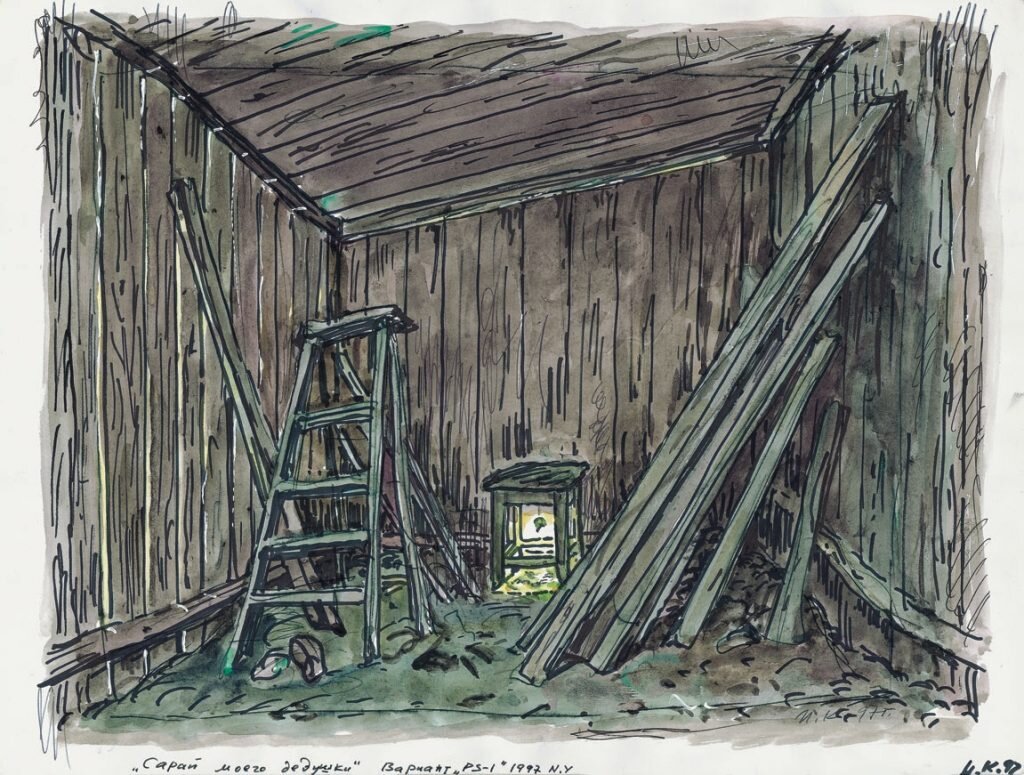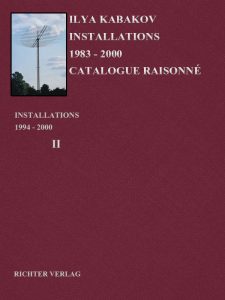My Grandfather's Shed
YEAR: 1997
CATALOG NUMBER: 113
PROVENANCE
Version 1
Destroyed in 1999
Version 2
Collection Museum van Hedendaagse Kunst Antwerpen, Antwerp, since 1998
See N0 118
Version 3
Formerly in the collection Mönchehaus Museum für Moderne Kunst, Goslar, since 1998
Destroyed in 2002.
Version 4
Collection Ackermans, Xanten, since 1999
K 21, Kunstsammlung Nordrhein Westfalen, on loan since 2002
EXHIBITIONS
Version 1
Contemporary Art Center, New York, United States
P.S. 1, 26 October 1997
Version 2
M HKA, Museum van Hedendaagse Kunst Antwerpen, Antwerp, Belgium
16 Installaties, 17 April – 23 August 1998 (as part of No 118, 16 Installations, Room 7)
Version 3
Mönchehaus-Museum für Moderne Kunst, Goslar, Germany
Ilya Kabakov, 16 October 1998 – 3 January 1999
Version 4
Galerie Thaddaeus Ropac, Paris, France
Ilya Kabakov. My Grandfather’s Shed, 1 December 1998 – 9 January 1999
DESCRIPTION
The installation is a large box resembling a small shed where you keep chickens or ducks. It is made of plywood and painted with a thin, white paint so that the surface of the plywood bleeds through the paint. In general, it has the appearance of a poor and rather old ‘worn’ look. There is a door on the side, also made of plywood that is half-open, and you can enter the shed.
Inside the shed it is dark, but in the corner opposite the door on floor-level something is shining brightly.
The light is coming from a small stool in the corner, a typical Russian chair without a back used to sit in the kitchen – not only in a Russian kitchen, by the way. The light is coming from under the stool (a light bulb is attached to the bottom of the stool) and illuminates the relief landscape that is fixed between the four legs of the stool. The landscape is touching and sentimental: a river is flowing between sandy banks, the hilly ground is covered with forest, there are houses along the banks of the river, a bell-tower …
Above this model, but also under the seat of the stool, hangs an angel, but it could also be a person with wings on his back. Like the landscape, he is illuminated, perhaps even more brightly than the landscape. The impression is created that he is descending. But at the same time, it’s as though he is always hovering over the illuminated and distant land.
The installation ‘works’ with an abrupt change of space – the gallery, the inside of the shed, and the distant, small (but, at the same time, expansive) space of land – all of this is in reverse perspective. Furthermore, a definitive role is played by the contrast of the light of the dark inside of the shed where the lighting is entirely Rembrandtesque. Also, of course, this setting is not devoid of a kind of marvelous, mystical atmosphere coupled with irony that is created by the stool in the corner and the lack of correspondence of all the scales: the viewer, the stool, the angel and the distant landscape below.
Changes in the Actual Installation in Contrast to the Original Proposal.
The stool with the angel and landscape stands not in the corner, but in the center of the wall opposite the fake entrance.
An additional corridor is built in the shed (it wasn’t there at first). In the first place, this is for delaying the ‘encounter’ with the stool – the viewer has to be inside the shed for a little while before the ‘encounter’ – as well as for greater protection from the light when the door is open.
The original proposal envisioned an empty interior of the shed; the viewer was supposed to approach the stool freely, and, bending down, examine the angel and the landscape. This action – of approaching and examining didn’t ‘work’ in the constructed shed. A barrier had to be placed between the viewer and the stool, a barrier of boards leaning toward the wall along with a ladder which cluttered the center of the shed, all so that the viewer only sees the stool at the end of the shed but cannot walk up to it. This distance made it possible to see the stool along with the actual space of the shed, and not only the one object (the stool) that stood by itself. It was in this combination – the cluttered, semi-dark shed, the weak light running inside through the cracks between the boards and the strange light coming from under the stool on the angel – that the installation ‘worked.’ By the way, with this ‘protracted’ distance, with the immobile (which turned out to be extremely important) point of viewing, the illuminated angel – with its wings toward us – became a brightly shining point, the center of the entire installation. This, of course, would not have been the case if the viewer had approached the stool in the corner freely since the dynamics would not have permitted him to see this.
The quantity of cracks between the boards used to form the walls turned out to be very important. It wasn’t so dark inside because of these cracks, and there was the required semidarkness for seeing the boards inside so as not to bump into them. Also, this external light of day contrasts well with the ‘mystical light’ under the stool.
Images
Literature








